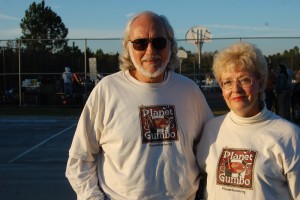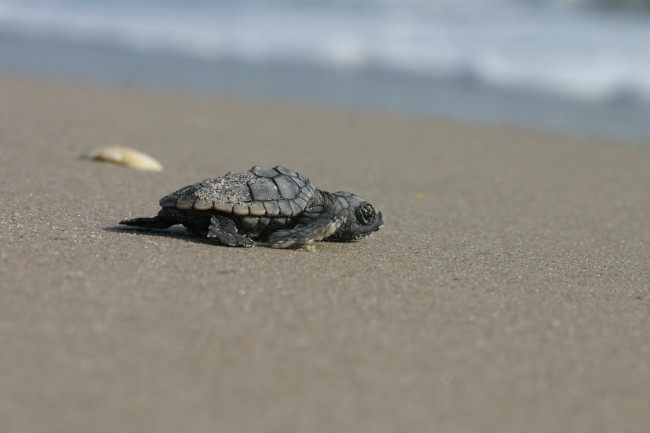
The survival of sea turtle species that have been on earth 110 million years depends on a ritual that begins every spring, as females climb out of the ocean to lay their eggs. That ritual will ramp up on Flagler County’s beaches (likely closer to May than March), where beach-goers will recognize the trademark wooden stakes and thin square-forming ribbons around nests–and steer clear of the sandy nurseries.
Florida’s sea turtle nesting season started this month and continues, pretty much parallel to Daylight Saving Time, through October. The Florida Fish and Wildlife Conservation Commission (FWC) is asking beachgoers to be careful and watch out for sea turtles coming ashore to lay their eggs. Leatherback turtle nests already have been documented this year on beaches in Indian River, St. Lucie and Martin counties.
“Please respect Florida’s sea turtles by leaving them alone and staying at a distance when you spot them moving across the sand or laying eggs,” said Robbin Trindell, who is responsible for sea turtle management at the FWC. “Sea turtles are resilient species, having been on earth for millions of years, but the turtles and their eggs and hatchlings are especially vulnerable whenever they appear on our beaches.”
The season in Flagler County officially begins May 1. Dale Hench, who with his wife Peach has been a member of the Volusia-Flagler Turtle Patrol for nine years, is part of the group of a little more than a dozen volunteers covering the 6 miles of sands in Flagler Beach, from Snack Jack’s to the south to Beverly Beach to the north.

During the season, every day before sunrise, members of the Turtle Patrol come out in pairs to check the sands for tracks. They patrol on ATVs and on foot.
Turtle Fest, the annual fund-raiser for Flagler Beach’s Turtle Patrol is scheduled for April 14 (the second Saturday in April), at the city’s Veterans Park, with entertainment, children’s activities, raffles and such. “That’s our primary fundraiser for all the commodities and the gasoline for the ATVs that we need,” plus the stakes, the ribbons used to mark the nests, Hench said. (See the Turtle Patrol’s website.)
Once a female sea turtle digs a nest on the beach with her rear flippers, she deposits about 100 eggs the size of pingpong balls. Then she covers up the nest with sand. Females often appear to weep as they nest, but the purpose of those tears is to remove salt from the turtle’s body.
Last year was an exceptional nesting year for sea turtles in Florida, with a record count for green turtle nests, and the number of leatherback turtle nests almost matching the record. Not so in the Flagler Beach area, where nests were down to 84.
Another important step that people can take to help sea turtle nesting is turning off or shielding outdoor lights that face the ocean. Sea turtle hatchlings may confuse artificial nighttime lighting on homes and businesses with the sparkle of seawater, and head in the wrong direction when leaving their nests. If confused turtle hatchlings end up heading inland instead of toward their watery habitat, they often die from dehydration, getting run over, or being preyed upon by raccoons, ghost crabs and fire ants.
In any case, a turtle’s chance of making it out of the nest and into the sea is 1 in 1,000, and a turtle’s chance of making it to sexual maturity is 1 in 10,000, Hench said. “The odds are definitely stacked against them, and of course once they hit the water, anything bigger than them, they’re appetizers,” he said. There is an average of 100 eggs in a nest. A turtle will lay about four and a half so-called “clutches” of eggs (of about 100 each) in a nesting season. Do the math: rare is the turtle that’ll be mother to a hatchling making it to maturity. That’s why the turtles are still endangered.
“I’m a little worried about the season this year because of the debate that’s going on over the bonfires on the beach,” Lori Ottlein, another member of the Turtle Patrol who’s also known as Flagler Beach’s Turtle Lady, said, “because of course having bonfires on the beach is very detrimental to the turtles and the hatchlings. Other than that. I’d really like to get started.” Ottlein was also concerned about the low number of nests last year, compared to the 134 nests the year before. “Hopefully this year will be an up year, and we’ll have more. You just never know. They do have an up year and a down year, but last year really was a down year.” (The Flagler Beach City Commission scheduled a workshop with state and federal officials on the bonfire issue, for April 3 at 5:30 p.m. at City Hall. The meeting is open to the public.)
Sea turtle eggs typically incubate for 45 to 60 days, and the hatchlings will emerge on Florida beaches through November.
Three sea turtle species, the loggerhead, green turtle and leatherback, nest regularly on Florida’s beaches. Two other species, the hawksbill and Kemp’s ridley, nest infrequently on the state’s shoreline. All five species are federally listed as either threatened or endangered.
You can report someone disturbing a sea turtle nest, or report a sea turtle that is being harassed, injured or dead by calling FWC’s Wildlife Alert Hotline at 888-404-FWCC (3922) or *FWC or #FWC on your cell phone. Or you can text [email protected]. For more information on sea turtles, go here.
Sea turtle conservation is supported by the “Helping Sea Turtles Survive” license tag available at www.buyaplate.com.





























Kip Durocher says
FYI
http://www.conserveturtles.org/pdf/florida/NWF_SeaTurtle.pdf
Art Woosley says
Great story, it is very nice and much appreciated having such dedicated people volunteering their own time to help to protect our sea turtles and their nesting areas etc.
There is however a similar somewhat over looked species, comparitively new comers with only a 60 million years in North America known as the gopher tortoise.
Gophers which have a life span of sixty years or more, are an important keystone species listed as threatened on the Endangered Species list. Unfortunately at the present time these creatures are struggling to survive, and do not appear to warrant very much respect or support from local officials, at least here in Flagler County.
For example the sand dune lots of Flagler Beach are a favorite home to gophers, but these building lots are still being clear cut of every bit of shrubbery on them. There is little to no regard for such insignificant creatures as the lowly gopher tortoise, tortoise which it is sad to say are often buried alive by construction equipment, and then can be covered with a concrete slab.
That’s right entombed alive, while I am not sure how long it takes for a tortoise to die in these tombs, I have been told that their death can be both long and painful.
Of course lots are meant to be built on which is understandable, but protection of our natural environment and the creatures which inhabit that environment deserve better. Increased vehicular traffic on our local highways also takes a great toll on gophers, as they slowly attempt to cross these roadways.
While our elected officials enjoy talking about growth and development which is fine, they must also step back once in a while, take a breath, and consider that we all inhabit this unique area together and by destroying that environment, it only serves to diminish this special place most of us call home.
Is it possible that both our county and city officials may pay heed to this on going problem, and that they will hopefully move towards setting up a responsible, well monitored enforcement program, which in turn will bring some sanity to the way these building lots are cleared ?
John Smith says
Well this a good story, and now the county is about to take the bon fire issue out of the cities hands by declaring a NO BURN BAN of open fires anywhere in the county, and that MEANS NO FIRES ON THE BEACH enough said.
Putnam county has just declared it so now the dominoes will fall. The county is suppose to hear it tonight from fire officials on how fire critically dry it is.